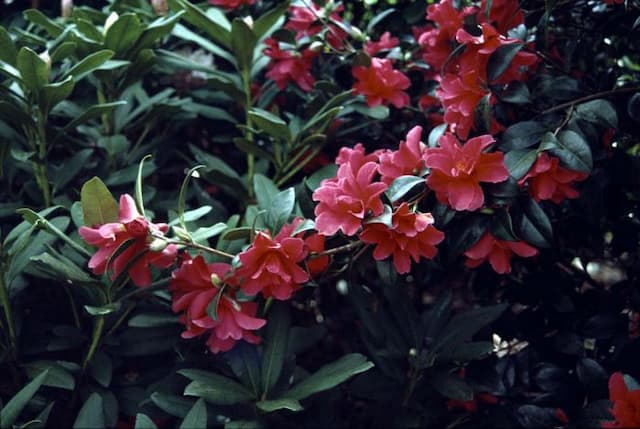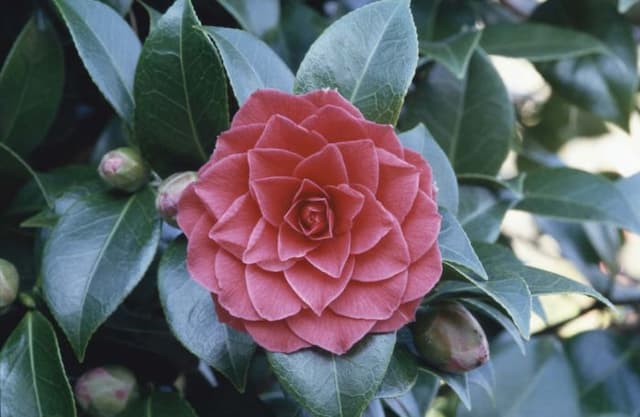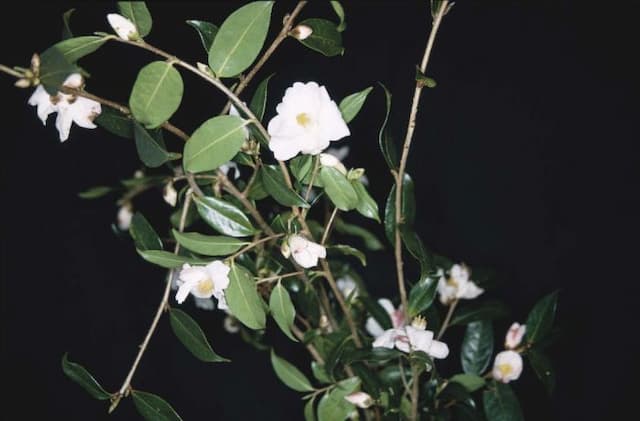Japanese Camellia Camellia japonica 'Drama Girl'

ABOUT
Camellia japonica 'Drama Girl' is a stunning ornamental plant notable for its vibrant, showy flowers which are a sight to behold. This camellia variety boasts large, peony-like blossoms characterized by a rich pink color with hints of deeper pink streaks running through the petals, creating a dramatic and variable pattern that stands out in any garden setting. The petals are numerous and have a ruffled appearance, adding to the luxurious feel of the flower. The striking blooms stand out against the glossy, deep green leaves that are typical of the camellia family. The leaves are leathery in texture with a slightly serrated edge and oval shape, forming a dense and lush foliage that serves as a perfect backdrop to the elaborate flowers. Flowering mainly in the late winter to early spring, 'Drama Girl' provides a splash of color during a time when many other plants are still dormant. Its elegant appearance makes it a popular choice for gardeners looking to create a focal point in their landscapes or for those who wish to enjoy cut flowers indoors.
About this plant
 Names
NamesFamily
Theaceae.
Synonyms
Japanese Camellia, Rose of Winter, Common Camellia.
Common names
Camellia japonica 'Drama Girl'
 Toxicity
ToxicityTo humans
Camellia japonica, commonly known as Japanese camellia, is not considered toxic to humans. There are no well-documented cases of poisoning from ingesting this plant, and it is generally recognized as safe for humans in terms of toxicity. However, ingestion of any plant materials can potentially cause gastrointestinal discomfort in certain individuals due to the plant's natural compounds or as a result of individual sensitivity.
To pets
Japanese camellia is also not considered toxic to pets. This includes cats and dogs, which means it is generally safe in households with pets. If a pet were to ingest part of this plant, it is unlikely to suffer from significant poisoning. However, as with humans, ingestion of plant material can potentially lead to minor digestive upset such as vomiting or diarrhea in some pets.
 Characteristics
CharacteristicsLife cycle
Perennials
Foliage type
Evergreen
Color of leaves
Green
Flower color
Pink
Height
6-12 feet (1.8-3.6 meters)
Spread
6-10 feet (1.8-3 meters)
Plant type
Shrub
Hardiness zones
7-9
Native area
Japan
Benefits
 General Benefits
General Benefits- Ornamental Value: Camellia japonica 'Drama Girl' has large, showy flowers which add visual appeal to gardens.
- Long Blooming: This variety often has a prolonged blooming period from winter through spring.
- Shade Tolerance: It can grow in partial shade, providing flexibility in garden design.
- Drought Resistance: Once established, it has a degree of drought tolerance.
- Evergreen Foliage: The plant maintains its glossy, green leaves year-round, offering constant foliage.
- Cold Hardiness: It is relatively cold hardy, making it suitable for a variety of climates.
- Wildlife Attraction: The flowers can attract pollinators such as bees and other beneficial insects.
- Low Maintenance: Requires minimal care once established, other than occasional pruning and watering.
- Soil Adaptability: Can tolerate a range of soil types, although it prefers well-drained, acidic soil.
- Versatile Landscaping Use: Suitable for use as a specimen plant, in borders, as privacy screens, or in containers.
- Cultural Significance: Camellias have a long history of cultivation in Asia and are often associated with elegance and grace.
 Medical Properties
Medical PropertiesThis plant is not used for medical purposes.
 Air-purifying Qualities
Air-purifying QualitiesThis plant is not specifically known for air purifying qualities.
 Other Uses
Other Uses- Ink Production: The petals of the Camellia japonica 'Drama Girl' can be used to create natural dyes for inks used in art and fabric printing, thanks to their deep pigmentation.
- Photography Prop: The vibrant flowers serve as a striking prop for still life photography, adding a touch of elegance to the composition.
- Handmade Paper: The fibers from the plant can be incorporated into handmade paper, giving it a unique texture and appearance.
- Floral Arrangements: Stems and leaves of the Camellia japonica 'Drama Girl' can be used in dried floral arrangements, providing a lasting and attractive display.
- Ceramic Glazing: The petals can be used in ceramic glazes to add color and visual interest to pottery and sculptures.
- Educational Resource: The plant can be used to teach botany, particularly in areas related to flower structure and reproduction.
- Natural Indicator: The pH sensitivity of the flower's pigments can serve as a natural indicator for science experiments.
- Garden Border: When planted in a row, the Camellia japonica 'Drama Girl' can create a dense, flowered border for garden paths.
- Craft Supplies: The durable leaves and petals can be used in various crafts, from scrapbooking to creating floral crowns.
- Culinary Presentation: Although not edible, the flowers can be used as a decorative element to enhance the presentation of gourmet dishes.
Interesting Facts
 Feng Shui
Feng ShuiThe Camellia is not used in Feng Shui practice.
 Zodiac Sign Compitability
Zodiac Sign CompitabilityThe Camellia is not used in astrology practice.
 Plant Symbolism
Plant Symbolism- Adoration: Known commonly as the Japanese Camellia, it is traditionally associated with adoration. The luxurious appearance of 'Drama Girl's' large flowers makes it a symbol for deep desire and love.
- Perfection: With its near-perfect blooms and symmetry, Japanese Camellias symbolize perfection or the ideal. 'Drama Girl's' rich color and form amplify this meaning.
- Longevity and Faithfulness: Japanese Camellias are evergreen, providing a symbol of longevity and faithfulness, as the plant itself is enduring and reliable throughout the seasons.
- Deep Affection: Gifted often as an expression of deep emotional affection, the Japanese Camellia can convey the message of someone being missed or longed for.
 Water
WaterThe Camellia Japonica 'Drama Girl', commonly known as Japanese Camellia, should be watered thoroughly to keep the soil moist but not soggy. During its growing season in spring and summer, water the plant about once a week with approximately 1 gallon of water per watering session, depending on soil type and weather conditions. In the fall and winter, reduce watering to about every 10 to 14 days, monitoring the soil moisture closely. If you're unsure whether the plant needs water, check the top inch of soil; if it's dry, it's time to water. Avoid overhead watering to prevent potential leaf and flower issues.
 Light
LightJapanese Camellia, prefers bright, indirect light or partial shade. A spot with morning sun and afternoon shade is ideal. Too much direct sunlight can lead to leaf scorch, while too little light can reduce flowering. Therefore, placing the plant in a location where it is protected from the hot afternoon sun is beneficial.
 Temperature
TemperatureThe ideal temperature range for Japanese Camellia is between 68°F and 75°F during the day, dropping to between 60°F and 65°F at night. This plant can tolerate minimum temperatures down to around 20°F for brief periods but should be protected from prolonged cold. Temperatures above 85°F for extended periods can stress the plant, and it is best to provide some shade during the hottest parts of the day.
 Pruning
PruningJapanese Camellia should be pruned to maintain shape, remove dead or crossing branches, and promote airflow within the canopy. The best time to prune is just after the flowers have faded, typically in late winter or early spring. This allows for shaping without sacrificing the following year's blooms. Prune sparingly, focusing on maintaining a natural shape and removing only necessary growth.
 Cleaning
CleaningAs needed
 Soil
SoilThe best soil mix for the Japanese Camellia 'Drama Girl' should be well-draining and acidic with a pH range of 5.5 to 6.5. A mix of peat moss, pine bark, and perlite or sand is ideal to provide both aeration and moisture retention. Regularly test and amend the soil to maintain the necessary acidity levels for optimal growth.
 Repotting
RepottingJapanese Camellia 'Drama Girl' should be repotted every 2 to 3 years or when it outgrows its current container. It's best to repot in the late winter or early spring before the new growth begins, taking care not to disturb the roots too much during the process.
 Humidity & Misting
Humidity & MistingJapanese Camellia 'Drama Girl' thrives in moderate to high humidity levels, ideally between 40-60%. The plant benefits from a humid environment but can tolerate lower humidity levels. To increase humidity, you can mist the leaves regularly or use a humidifier.
 Suitable locations
Suitable locationsIndoor
Place in bright, indirect light; keep soil moist and well-drained.
Outdoor
Provide partial shade; shelter from harsh sun and winds.
Hardiness zone
7-9 USDA
 Life cycle
Life cycleCamellia japonica 'Drama Girl', commonly known as the Drama Girl Camellia, begins its life as a seed, which germinates to produce a small seedling. With proper conditions, the seedling establishes roots and stems, developing into a juvenile plant with characteristic glossy, evergreen leaves. As the camellia matures, it enters the flowering stage, blooming typically in late winter to early spring with large, showy pink flowers that attract pollinators. After pollination, it sets seed in the form of a dry capsule, which then ripens and eventually releases seeds to start a new cycle. In ideal conditions, Camellia japonica 'Drama Girl' can live for many decades, going through annual cycles of growth, flowering, and seed production. Pruning and deadheading spent flowers encourage healthy growth and can help extend the life of the plant.
 Propogation
PropogationPropogation time
Spring-Early Summer
Camellia japonica 'Drama Girl', commonly known as the Japanese Camellia, is most commonly propagated through semi-hardwood cuttings. The best time to take cuttings is in late summer when the current season's growth has begun to mature. Cut a 4 to 6-inch-long (10 to 15 centimeters) section of stem that includes two to three sets of leaves from a healthy parent plant. The lower leaves should be removed, and the cut end dipped in rooting hormone to encourage root growth. The prepared cutting should then be inserted into a pot filled with a mixture of peat and perlite, ensuring at least one set of leaves remains above the soil surface. This container should be kept in a warm, humid environment with indirect sunlight. Roots typically develop in several weeks, and once established, the new Camellia can be transplanted into a more permanent location.









